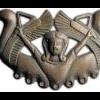-
Posts
32 -
Joined
-
Last visited
-
Days Won
1
Argantonius last won the day on January 21 2014
Argantonius had the most liked content!
Recent Profile Visitors
1.836 profile views
Argantonius's Achievements

Discens (2/14)
3
Reputation
-
Fun fact: In 0 AD's timeframe beavers lived also in Mediterranean Europe. The Romans said they were numerous in the Guadalquivir. So consider them not out of place in other maps with water. I suggested the Capercaillie (Tetrao urogallus) or the Black Grouse (Tetrao tetrix) in Alpine and Temperate and the Great Bustard (Otis tarda) in Mediterranean and steppe maps. It doesn't live in India or Africa but there are other very similar bustards there. If it doesn't fly (he-he) peacocks and ostriches are suitable replacements in these places. The Ptarmigan was listed as part of Tundra but could also appear in Alpine.
-
These are the most realistic wolves I've seen in a videogame. Ever.
-
This seems more fitting for Abrahamaic religions than ancient polytheists (and even then I'd favor a name like Martyrdom over just simple Faith). How about Organized Religion, Priestly Class, Theocracy or even Religious Donations (because your subjects are feeding your priests better?). Either name works in its own way I suppose. "Zealotry" is another option. "Animal/Ritual Sacrifice" can work too as already pointed. Barely related to that (because it made me think of Numantia and Massada) I propose: "Siege Rations" - Increases your (fighting) male population HPs and decreases the HPs of other units like women, priests and traders (domestic animals too?). Meant to be hit only when you are fighting for your base, obviously. By the way, I had not the chance to do a naval battle yet. Is capturing ships (by enemy ships) implemented or planned?
-

Unit And Building Names
Argantonius replied to Davarish's topic in Game Development & Technical Discussion
Hello back. I found this that you might want to check, an Etymological Dictionary of Basque in English. This one is especially great because it says when a word is lent from Spanish or other language. http://web.archive.org/web/20110607202936/http://www.sussex.ac.uk/linguistics/documents/lxwp23-08_edb.pdf I noticed that the new blacksmith building doesn't have a name. According to this document it could be [h]arotz ("smith"). An alternative ol[h]a is identified as "forge, foundry" but then says that it can mean just "place". Other changes: Cantabrian Cavalry / "Caballero Cantabro" - > Kantabriako Zaldun (interestingly the document notes the similarity between Basque zaldi, horse, and thieldo, a "Hispanic" word for horse recorded by Pliny. This one identifies baratze not as "orchard" but as "garden" instead. Several other words are given for "field" including okuntza, berro/berho and ganbo/kanbo (from Latin Campus) for "sown field"; sor[h]o for "field, meadow, estate, farm"; and galsoro for "wheat field". Azoka apparently comes from Arabic Suq so it's barely better than Merkatu. Other words for "Market" cited are zeia and arruga. -
Ugh no no no no! 2000 years off date and it can hardly be considered 'monumental' by any means. The Iberian wonder should be something based on the Cancho Roano sanctuary complex (built c. 550 BC, destroyed by fire c. 370 BC). Really, it's the only thing trully native (although some say it has Phoenician influences) and trully monumental building in the Iberian Peninsula close to the game's period (I know you already used the Pozo Moro tombs as models for the Iberian "venerated monument"). http://www.iam.csic.es/imagenes/proyectos/CANCHOROANO.jpg http://1.bp.blogspot.com/-PoBahv2XsdY/TeCnsoBZ_HI/AAAAAAAAB0U/od4xEXaz8UE/s400/cancho_roano1.jpg http://www.vivirextremadura.es/wp-content/uploads/014_cancho_roano_07.jpg http://www.manuelgago.org/blog/wp-content/uploads/cancho_3.jpg Restorations http://www.uv.es/~alabau/Image17.gif http://doc-0k-8g-3dwarehouse.googleusercontent.com/3dwarehouse/secure/hhulr73hmmak89paul31eote4ben7ngk/9aquol2022gampo3sr0lus4j8c5fv5le/1358121600000/lt/*/57477ce6f9a6a80ae1f84a94ad02d528?ts=1206578288000&ctyp=other http://1.bp.blogspot.com/-guULYkruJtU/TsK1mTZnQXI/AAAAAAAAB70/-NQkXBoGtyA/s1600/Sin%2Bt%25C3%25ADtulo%2B1.png Objects found inside http://www.uv.es/~alabau/Image19.gif http://kikeoliva.files.wordpress.com/2009/11/fig6_1-cancho-roano.jpg?w=655 http://www.hoy.es/prensa/noticias/200803/27/fotos/006D4BADP3_1.jpg This is an example of Tartessian culture. In general, the Tartessians (and their successors/descendats, the Turdetanians) were the Iberians more civilized and received a lot of influences from Greeks and Phonicians. In fact, the game's Iberian temple is based on a Tartessian temple IIRC. Some locations even have temples to East Mediterranean divinities like this Ishtar temple from El Carambolo near Seville: http://multiply.com/mu/almogavar/image/2/photos/127/600x600/7/103-0278.JPG?et=0SDEhoe7pShOUBflJYOZ4w&nmid=294704519(first phase) http://multiply.com/mu/almogavar/image/20/photos/127/600x600/8/103-0279.JPG?et=67kl1aipC3yckk6LA%2CDbJA&nmid=294704519(second phase) http://multiply.com/mu/almogavar/image/2/photos/127/600x600/9/103-0280.JPG?et=NtZSfV1VO%2Cv795W3ps8u%2BQ&nmid=294704519 http://www.elcorreoweb.es/resources/archivos/2011/1/22/1295727741814gransev20dn.jpg Now, of course, was this Iberian or Phoenician? Well, I'm not sure, that's why I did not propose it as an Iberian wonder. But Cancho Roano is so far inland and so separate from Phoenician ports and trade routes that it only can be the work of natives. Others that could show up as eye candy in Iberian maps and the scenario editor are the Guisando bulls in the province of Avila (2nd century BC). http://3.bp.blogspot.com/-gZbaJgor-M4/TpMIE83LjTI/AAAAAAAAAIs/-D4LTxcgKi8/s1600/Toros_de_Guisando.jpg http://esphoto980x880.mnstatic.com/los-toros-de-guisando_397104.jpg These are the biggest and are quite eroded, but bull statues are common in the Iberian Peninsula through the period http://upload.wikimedia.org/wikipedia/commons/9/90/Toro_%C3%ADbero_de_Osuna_%28M.A.N._Madrid%29_01.jpg http://www.cronicadigitaldejaen.es/cronica/paginas/44/4.-_Toro_iberico_de_Arjona._Museo_arqueologico_de_Granada.Foto_I._Castro.JPG http://1.bp.blogspot.com/_-pxkw--56s0/TTH1IhGX1KI/AAAAAAAAANM/_qAKpW3u00E/s1600/TORO+PORCUNA.jpg http://www.decorarconarte.com/WebRoot/StoreES2/Shops/61552482/49A3/AC5E/EFB3/779A/678F/C0A8/28B8/78AD/web50003%5B1%5D.jpg along with combinations of bulls with other things http://almansaenbici.usuarios.tvalmansa.com/encuentros/imgs/E5Balazote_Bicha.jpg lol Alternatively if the Iberian civ gets divided between an Iberian proper and a "Celtiberian" one (including not just the Celtiberians but other Celtic/IE peoples of the Western Iberian Peninsula like the Lusitanians and the Cantabrians) the Guisandos could be the Celtiberian wonder and Cancho Roano the Iberian proper wonder. I know it's unlikely but there there is the Gaul/Briton partition precedent.
-
By the way, since there is a donkey model already (as part of the Iberian and Celtic trader units) what about including some wild asses/onagers (desert, steppe, mediterranean)?
-
Well, I have to say, if the reason the Iberians don't have warships is because it wouldn't be historically accurate then giving them equally historically inaccurate fireships as an alternative doesn't make much sense, right? I agree with those that suggested giving Iberian buildings an extra attack versus ships, and making trade ships able to fire arrows when garrisoned by ranged units (not just for Iberians, but all civilizations - and not fishing ships, that would be silly). These "armed merchants" would be the crappiest of the crappiest of "warships" but they could help you buy time while you build a proper fleet or if you are momentarily out of gold and all your warships have been sunk. And lo, if the player is stup... I mean brave enough to choose Iberians and an islands map, then he could still win by spawning merchants and slingers/javelineers, and fortifying every little island with resources or strategic value. It would be slow and expensive but possible nonetheless.
-
I use a small computer and clicking on the chickens is difficult already. So, instead of pheasants and partridges, can I suggest the gamebirds to be of bigger species instead such as: - Great Bustard (Mediterranean, Temperate, Steppe) - there are similar species in Africa, Arabia and India too - And of course the Ostrich (Desert and Savanna) - it was present in North Africa and the Middle East in Roman times too Or you could just ignore me. That first peacock is absolutely gorgeous.
-
Ivory was a highly demanded material in ancient times and has continued to be so until practically the modern day. Some old threads such as this suggested including it as an additional resource in some maps but that would be over-complicating the issue. Say, instead, that some animals provide an additional ammount of metal when hunted - after all, ivory was traded for gold almost as soon as it was obtained, and a pair of tusks collected in Africa would pass from hand to hand all the way to western Europe or Japan before actually being carved. This would require a new animation for the women and citizen-soldiers though, carrying one or two white tusks over their shoulders as they move to drop the metal in a building. The animals that provide metal by way of ivory would be the most dangerous when attacked, giving the player an incentive to attack them instead of leaving them alone - elephants, hippopotamuses (both of whom would be able to destroy buildings) and walruses (the current plan list has them as fleeing huntable animals but in reality they are very dangerous when pissed off and have been seen "convincing" polar bears and orcas that attacked them to leave them alone). Other sources of ivory could be treasure-like elephant skeletons in desert/savanna/tropical maps and mammoth frozen carcases in polar maps. These ones could also include narwhals, who would be the only animals-that-provide-metal that are inoffensive and collected by fishing boats. A final though. Once herding is implemented, some types of elephant (Asian and North African) could be herded by some civilizations only (Persians and Carthaginians). The player that is using these civs would have to decide if he prefers having cheaper war elephants (herding) or an instant package of food and metal (hunting). Now, the player that *isn't* using those civs could decide to troll the opponent player that is herding elephants, and unless whatever building is holding them is well guarded he could sneak some men in and get some steaks and metal for free. tl;dr Some animals provide food and metal. From most to less amount (also danger): - African Bush Elephant (Savanna, Tropical African Maps - not herdable) - Asian Elephant (Tropical Asian - herdable) - North African Elephant (Desert, Mediterranean - herdable) - Hippopotamus (Desert, Savanna, Tropical African - not herdable) - Walrus (Polar - not herdable) - Narwhal (Polar - sea animal) - Elephant Skeleton (Mediterranean, Desert, Savanna, Tropical - only metal) - Mammoth Skeleton (Polar - only metal) Thoughs?
-
As of now there are no camel units (other than traders and wild animals), right?
-
The reason I assumed that there was sarcasm involved was because the word "Castro" is currently used in the game to name the Iberian fortress building, something that some, me included, have argued against.
-
Okay. Let me rephrase that. Wouldn't an hypothethical Etruscan faction... ...just look like the Greek one?
-
Gotta refine your sarcasm good sir - I don't know exactly what do you want to tell me. Isn't there a Stonehenge model already btw? Maybe just polish that and darn accuracy. Or use it for the "King of the Hill" scenarios (I personally prefer something like the "Ruins" in the very first AoE rather than having random wonders show up in the middle of nowhere like in AoK).
-
For the Iberians google something on the Cancho Roano temple complex it's probably the best you can aim for there. Not sure about the Celts. Maybe some sacred tree/forest or am I getting that confused with the Germanics lol.
-
ROFL btw... Isis? Greco-Egyptian fertility goddess, Augustus tried to curtail her cult without success.



